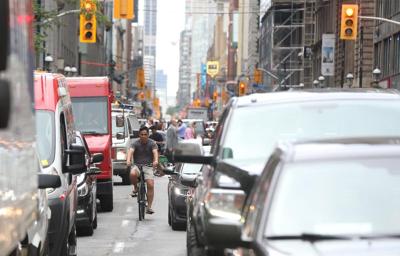Toronto police data on injured pedestrians and cyclists provide an incomplete picture, said researchers who crunched hospital records in a bid to help make city streets safer.
At the request of the City of Toronto, the researchers identified more than 30,000 emergency visits by injured cyclists between 2016 and 2021. Police records of cyclists killed or injured over the same period number 2,362, only eight per cent of the total.
Police records captured a higher percentage of injured pedestrians but missed almost half of those who sought emergency treatment.
One reason for the gap is that police generally only attend a scene when a vehicle is involved in the injuries, said Alison Macpherson, a professor at the School of Kinesiology & Health Science at York University and lead author of a new research report aimed at getting a fuller picture of road injuries.
“One of the surprises in our study is that, both for hospitalizations and for emergency department visits, about 80 per cent of the bicycle-related injuries were not reported to have involved motor vehicles,” said Macpherson, who is also a senior adjunct scientist at ICES, a health services research non-profit.
“It’s important to underline that police data are not intended to capture all injuries, and using emergency department hospitalization data helps us to understand the burden of cycling and pedestrian injuries,” to better inform city officials devising ways to make streets safer, she said.
Macpherson noted that police records include locations where injuries occurred, while hospital records cover a wider range of injuries.
“Ultimately it would be amazing if those (police and hospital) data could be linked and we can get a complete picture,” she said.
The study published in the academic journal Injury Prevention was led by ICES and York University in collaboration with Toronto Metropolitan University.
The number of cyclists on Toronto streets increased amid the pandemic that started in 2020, and so did their injuries, according to a 2021 Toronto Star analysis of hospital records.
Jess Spieker, a cyclist who suffered a broken spine and brain injury when a driver hit her in 2015, said she and other road safety advocates have long known that police records “underestimate road violence because many people are not comfortable dealing with police for excellent reasons.”
Also, police records would usually not capture injuries from cyclists getting wheels caught in streetcar tracks — a problem that can be addressed with track inserts that streetcars depress — or hitting construction material left in bike lanes, said Spieker of Friends and Families for Safe Streets.
Getting a fuller picture of cyclist and pedestrian injuries should help the city’s Vision Zero efforts to end road deaths, she said.
Toronto Police Service said it has set “global standards” for open data through its public safety data portal that includes collisions where people are seriously injured or killed as well as new capabilities to identify road users involved as drivers, passengers, motorcyclists, cyclists and pedestrians.
“We do not report on other external data sources, which we cannot verify,” the police said in a statement. “We encourage members of the public to report all collision incidents to TPS as road safety is improved through evidence-based design.”
A spokesperson for the city welcomed the new research study, saying that “the city looks forward to working with both the ICES and the Toronto Police Service to continue to develop higher quality data sets that will improve the safety of pedestrians and cyclists.”




























To join the conversation set a first and last name in your user profile.
Sign in or register for free to join the Conversation